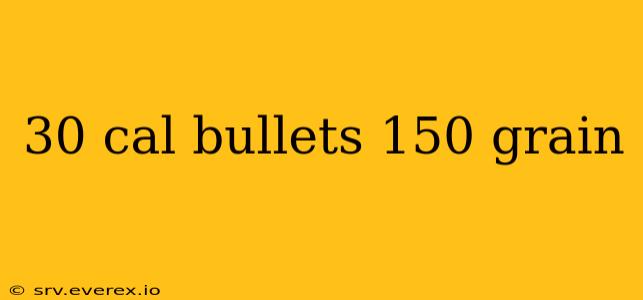The .30 caliber, with its long history and widespread use, offers a diverse range of bullet weights and designs. Among these, the 150-grain bullet stands out as a versatile option for various applications, from hunting to target shooting. This article will explore the characteristics, performance, and suitability of 30 caliber 150 grain bullets across different contexts.
Understanding Grain Weight and its Significance
Before delving into the specifics of 150-grain .30 caliber bullets, it's crucial to understand the concept of grain weight. A grain is a unit of mass, and in the context of ammunition, it refers to the weight of the bullet itself. A heavier bullet generally translates to:
- Increased momentum: This results in greater penetration and knock-down power, making it effective for larger game hunting.
- Lower velocity: Heavier bullets typically travel at slower speeds compared to lighter bullets of the same caliber, fired from the same firearm.
- Higher recoil: The increased mass leads to a more noticeable recoil.
30 Caliber 150 Grain Bullet Performance
The performance of a 150-grain .30 caliber bullet is significantly influenced by the specific bullet design, powder load, and the firearm used. However, some general observations can be made:
Hunting Applications
A 150-grain .30 caliber bullet is frequently chosen for hunting medium-sized game, such as deer, antelope, and hogs. Its balance of penetration and energy transfer makes it effective for clean kills, provided proper shot placement is achieved. Different bullet designs (e.g., expanding, soft-point, bonded) offer varying degrees of expansion and retained weight, affecting their performance on game.
Target Shooting
For target shooting, 150-grain .30 caliber bullets can provide excellent accuracy and consistency, particularly at longer ranges. Full metal jacket (FMJ) bullets are often preferred for their durability and consistent performance. However, the choice will depend on the specific target shooting discipline and the shooter's preferences.
Other Applications
Beyond hunting and target shooting, .30 caliber 150-grain bullets find applications in:
- Law enforcement: Some agencies may utilize this bullet weight for patrol rifles or carbines.
- Self-defense (depending on jurisdiction and firearm): Although not as common as other calibers, it could be used in certain circumstances. This area requires careful consideration of local laws and responsible gun ownership practices.
Choosing the Right 30 Caliber 150 Grain Bullet
Selecting the appropriate 30 caliber 150 grain bullet depends on the intended application. Key factors to consider include:
- Bullet construction: Full metal jacket (FMJ), soft point (SP), jacketed hollow point (JHP), bonded, and other designs impact expansion, penetration, and overall performance.
- Manufacturer: Reputable ammunition manufacturers consistently produce high-quality bullets with reliable performance.
- Intended use: Hunting, target shooting, or other applications will influence the choice of bullet type.
- Rifle specifications: Always consult your firearm's manual to ensure compatibility with the chosen ammunition.
Conclusion
The 30 caliber 150-grain bullet offers a compelling combination of power, accuracy, and versatility. By understanding its characteristics and carefully considering the specific application, shooters can make informed decisions to achieve optimal performance. Remember that responsible gun ownership, safe handling practices, and adherence to all relevant laws and regulations are paramount.
